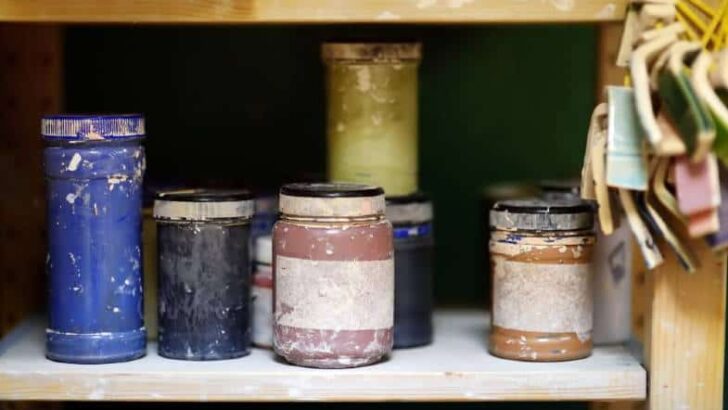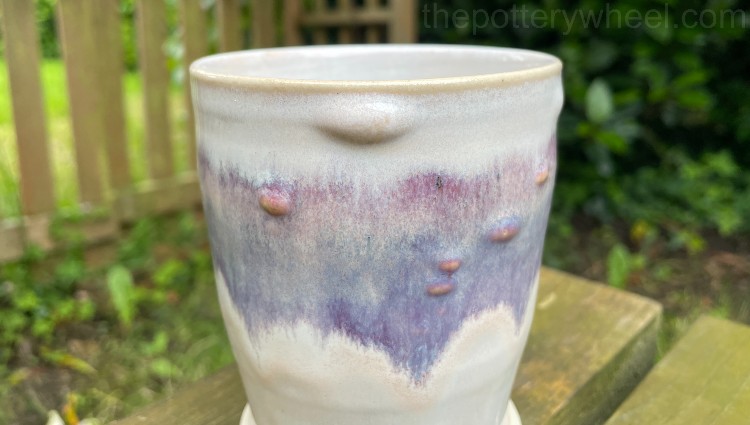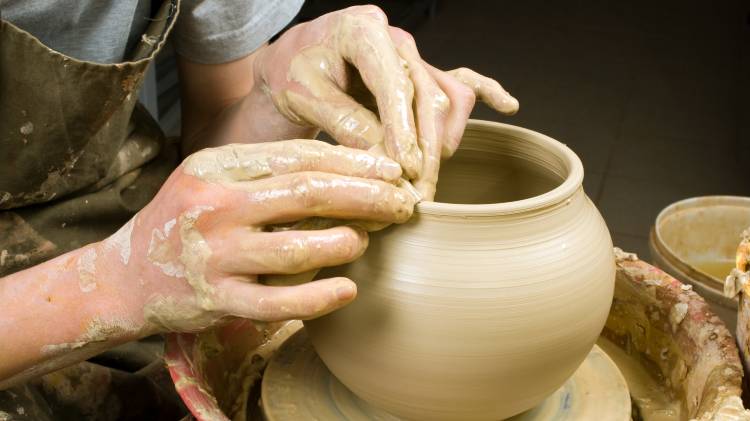I recently made a lovely red terra cotta vase, and bisque fired it. I was wondering what glaze to use when it occurred to me that a nice white slip would look good. But I had already bisque fired it and I wondered, can you apply decorating slip to bisque. So, I did a little research and this is what I found out…
Slip is made mainly from clay suspended in water. Some readymade shop-bought decorating slips have other ingredients. Nevertheless, decorating slips are largely clay. Clay slip shrinks when it dries, so when it’s applied to bisque it often flakes off. However, some slips and engobes are specially made for bisqueware.
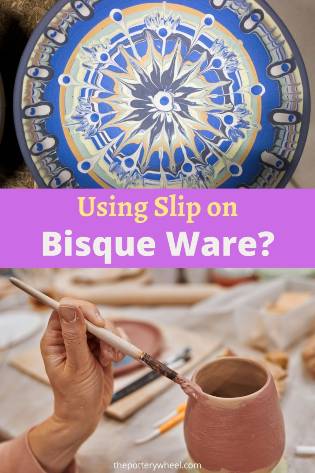
Problems when Using Slip on Bisque
Clay shrinks when it dries and also when it is fired. The reason it shrinks when it dries is mainly to do with water content. The exact percentage of water content in clay varies between different types of clay. However, a general rule of thumb is that wet clay contains around 30% water. When this evaporates as clay dries, the clay loses volume.
Also, as clay is fired, the clay particles densify and move closer together. This also causes pottery to shrink.
So, a piece of bisque-fired pottery will be smaller than it was in was workable plastic clay.
If you have made your own clay slip, it is most likely just clay particles suspended in water. Clay slip is great for joining pieces of clay together, and also for decorating your pottery too.
However, the best time to apply clay slip to your piece is when your pot is still quite moist. The drier your pottery becomes, the more it will have shrunk.
If you then apply liquid slip to the piece, the slip will also have to dry out and shrink. As it does this it will crack and flake off. To avoid flaking, it’s best to apply the slip when the clay is still wet. This way the clay and the slip will shrink together.
Sometimes potters will apply slip to leather hard clay and get away with it. But there are different stages in leather hard clay, and the earlier stages contain more water. Slip is more likely to flake off drier leather hard clay. It’s best to apply it to the earlier stages of being leather hard.
Can Slip Ever be Used on Bisque?
It stands to reason that you will have problems with flaking if you use slip on bisque. Bisque pottery has no water content and has done a significant amount of shrinking already. Slip used on bisqueware will likely shrink and pull away from the bisque surface.
This is certainly the case if you have made your own slip. And it is also true if you have bought readymade decorating slip, which is also mainly clay and water.
However, if you really want to try using slip on bisque, then there are ways that this can be done. Here are some options that you can try if you like….
Engobe
Engobe is sometimes described as being halfway between slip and glaze. Slip is normally made of clay, water, and often a colorant. Engobe also has high clay content, but it contains less clay than slip. In addition to this engobe’s contain additional ceramic ingredients including silica and flux.
The added ingredients in an engobe reduce how much it shrinks when it dries. This means that a lot of engobes can be used on bisqueware.
Because engobe contains some silica and flux they do behave a bit more like glazes when they are fired. Fired engobe will sometimes have a bit of a sheen to it because it has melted more than slip. However, they don’t melt to the same extent as a glaze, and shouldn’t create a glassy finish.
Instead, a good engobe will produce a nice velvety, rich, opaque finish like a colored slip.
Casting slip
Some potters use casting slip to decorate bisqueware. Casting slip is manufactured to be poured into molds for the purpose of making cast ceramics.
However, it doesn’t shrink as much as regular clay slip. So, it can be painted or sprayed onto bisqueware as a decorating slip too.
Casting slip can be bought in powdered or ready-made liquid form. You can add colorants to the slip in the form of oxides or stains.
It’s important that the slip you use fires in the same temperature range as the clay body you are using. For example, if you are using earthenware clay, buy a low fire casting slip.
Casting slip can be bought to suit different firing ranges, including earthenware, stoneware, and porcelain.
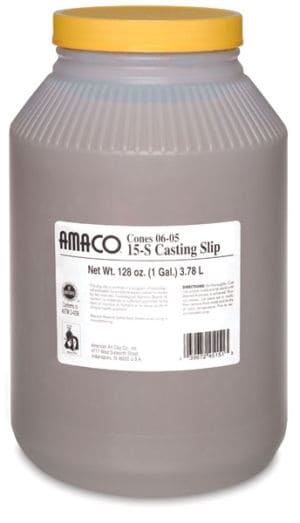
If you want to try using a casting slip as a decorating slip, it’s best to experiment on a few pieces first. Done use it on a whole kiln load of pieces before you have tried it out first. It’s best to test the clay body you are using with the casting slip you have.
Paper Clay Slip
Another option is to use paper clay slip. Paper clay slip is simply slip that contains added paper fiber. Paper clay slip is often recommended as a good way of joining pieces of greenware clay together. The reason for this is that the paper fiber in the slip gives the join a lot of additional strength.
However, adding paper fiber to slip has the added advantage of reducing the amount that the slip shrinks. And for that reason, some potters will use paper clay slip on bisque.
It is easy enough to make paper clay slip. Here are the steps that I use…
Making Paper Clay Slip
- Dry out some small pieces of the clay body that you are using. When they are bone dry, put them into a container and add some water. You don’t need a lot of water, just enough to cover the dry clay. Wait for the clay to slake down (dissolve).
- Tear up some paper and put it in some water. Allow the paper to soften in the water. Then blend the paper and water together with an electric stick blender. The liquid that you have should be smooth rather than having lumps of paper fiber in it. The amount of paper you use depends on how much slip you are making. I use sheets of toilet tissue as it dissolves quickly. A few sheets of toilet tissue for a handful of bone dry clay is about the ratio I use.
- Add the liquid paper fiber to the clay slip and mix it together thoroughly with the hand blender.
- You can add more water if you want to thin the clay slip down. Equally, if the mixture is too thin, let it sit for a while. The clay and paper will settle and you will be able to siphon any excess water off the top.
Making your Own Bisque Slip
Some slip is specially formulated to be used on bisqueware. This is known a bisque slip. Bisque slip is typically much thinner than regular decorating slip.
You can alter decorating slip so that it has the thickness you want. Slip that is used for slip trailing is normally quite thick. This is because you want it to have a raised texture on the pottery. Whereas clay slip that is being airbrushed or sprayed onto pottery needs to have a thinner consistency.
However, bisque slip really does need to have a much thinner consistency than a normal decorating slip.
If you want to experiment with making your own bisque slip there are plenty of recipes online. You could start out experimenting with the slip that you normally use. Try thinning it out with water and applying that slip on bisque. You might have some success. With ceramics, you often don’t know what you will get until you try it out. So why not test it on a small test tile and see what the results are?
Alternatively, you might want to dive straight into making your own bisque slip. The glazy.org website is a good place to start looking for bisque slip recipes. Simply type bisque slip into their search bar and you will find a selection of recipes.
You will find Johnston’s White Slip for Biscuit on Glazy. Here is the recipe:
| Ingredients | Percentages |
| EP Kaolin | 48% |
| Silica | 26% |
| Custer Feldspar | 26% |
| 100% |
Final Thoughts
Applying slip on bisque is not without its problems. If you simply apply your regular decorating slip on bisqueware the slip is likely to crack off as it dries. However decorative slip has a lovely rich, velvety look that you may prefer to underglaze. If you want to try applying slip on bisque, it’s worth giving some of the suggestions made above a go.

